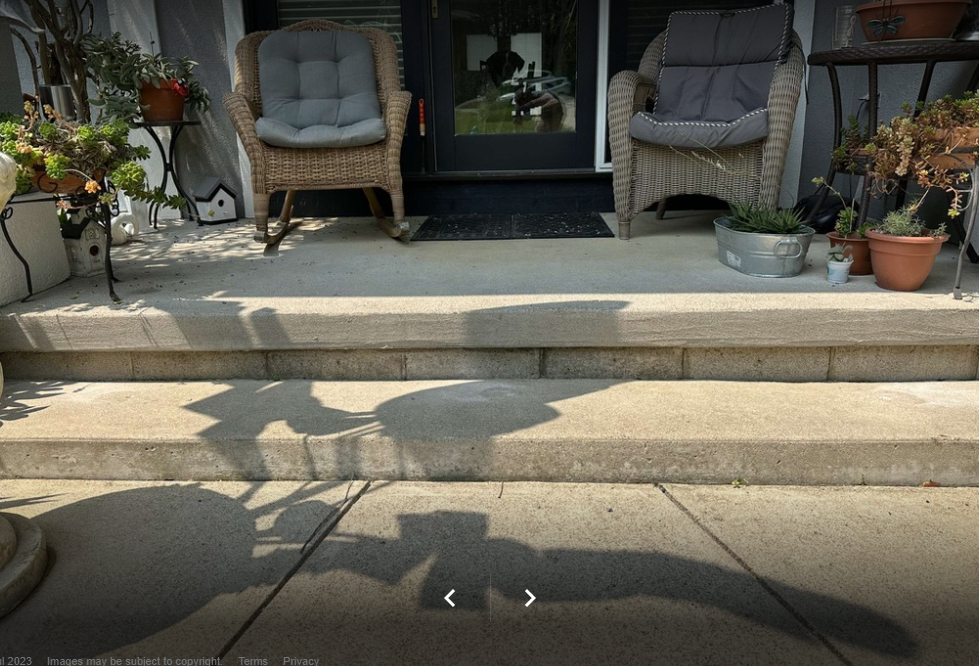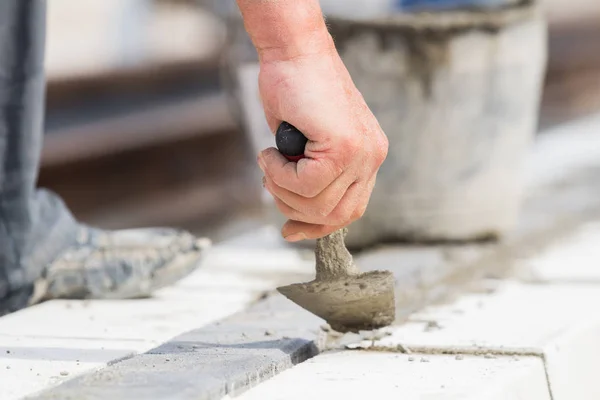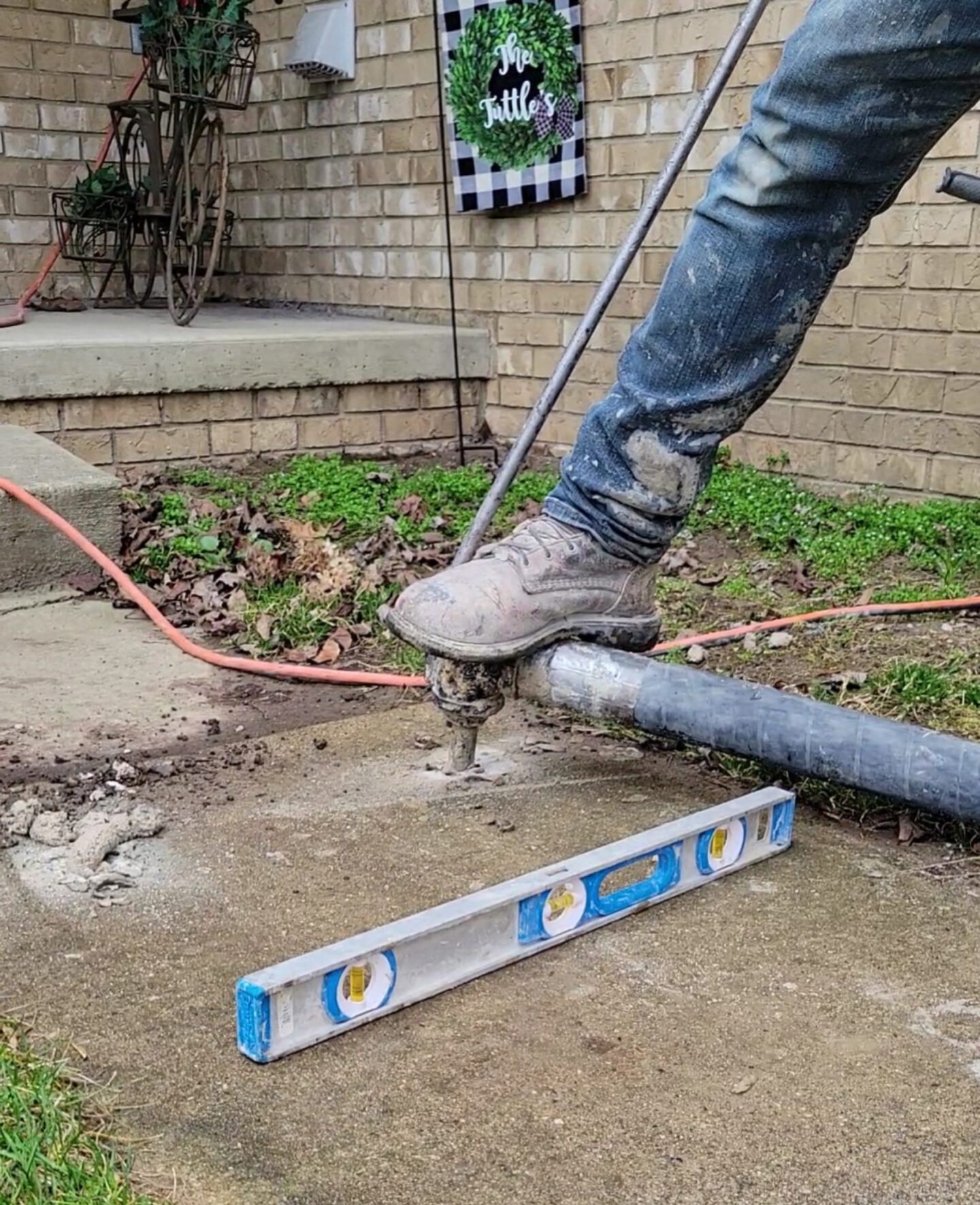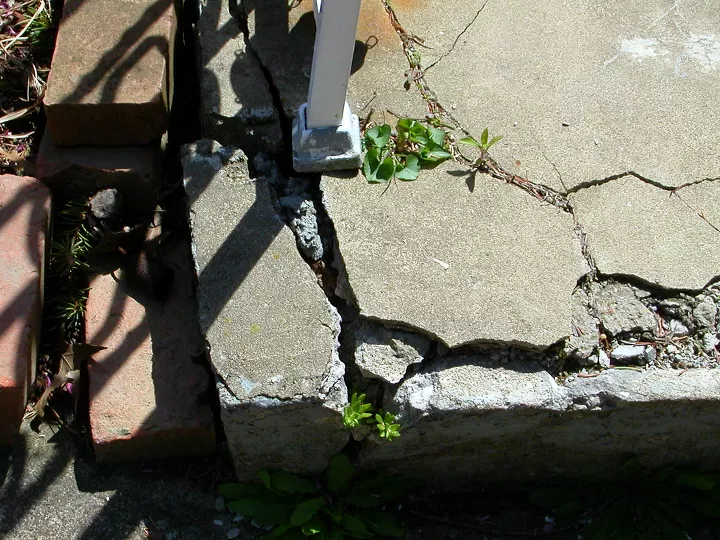

Are you wondering if your concrete issues can be solved by concrete leveling? Concrete leveling, also known as mudjacking or slabjacking, is a process used to level sunken or uneven concrete slabs. It involves pumping a mixture of water and limestone or PolyFoam beneath the affected area to raise it back to its original position. While concrete leveling can be a cost-effective solution to many concrete problems, it may not be suitable for all situations. It’s always best to schedule a free assessment of the area by a trained contractor but in this article, we will explore what can and cannot be leveled with concrete leveling to help you determine if concrete leveling is right for you.
Driveways: Concrete driveways can become uneven over time due to soil erosion or settling. Concrete leveling can help to restore the surface and prevent further damage.
Patios: Patios can also become uneven due to soil movement or water drainage issues. Concrete leveling can help to restore the patio to its original level, making it safer and more attractive.
Sidewalks: Uneven sidewalks can be a tripping hazard and may also cause damage to vehicles. Concrete leveling can help to eliminate these issues and restore the sidewalk to its original position.
Garage floors: Garage floors can become uneven due to soil movement or water drainage issues. Concrete leveling can help to restore the garage floor to its original level, making it easier to park vehicles and perform other activities.
Interior floors: If, your home, parts of your home, or your building is on a slab, concrete leveling can help. Uneven interior floors can cause problems with moisture and may also be a safety hazard. Concrete leveling can help to eliminate these issues and restore the interior floor to its original level. In commercial and industrial applications, void filling under the concrete is a great way to ensure the load bearing capacity of the concrete and prevent cracking.
Pool decks: Uneven pool decks can be a safety hazard and may also cause damage to the pool. Concrete leveling can help to eliminate these issues and restore the pool deck to its original level.
Steps: Uneven steps can be dangerous and may cause injury. Concrete leveling can help to eliminate these safety issues and restore the steps to their original level.
Standard concrete: If you have standard concrete, whether it is new or old, concrete leveling is a great solution for fixing uneven slabs, trip hazards and water pooling issues.
Colored concrete: If your concrete his died, concrete leveling can be done and color matching techniques can be used to dye the injection holes to help blend them to the color of the existing concrete
Stamped concrete: If the concrete surface has decorative elements, such as stamped patterns or designs, concrete leveling is an easy solution and often times, we can hide the injection holes within the pattern to make them less noticeable.
Exposed aggregate: If your concrete has exposed aggregate, which is visible decorative stones on the concrete’s surface, concrete leveling can be done. Professional concrete leveling contractors can determine the type of stone used during your concrete leveling assessment and ensure similar stone is used when patching the injection holes to make them less noticeable
Mildly cracked concrete: If you have one to three cracks in a slab of concrete, depending on the size of the sections, it is usually possible to level the concrete. Additional crack repair may be recommended, however the leveling process can still fix most common uneven concrete concerns.
Extreme settling: If the concrete has settled several inches, bringing it back to its original position with concrete leveling is common. There is no limit on how far concrete has dropped or sunken to return it to its original standing.
Large voids: If there are large voids beneath the concrete, concrete leveling may be a suitable solution. In such cases, the voids may need to be filled before any concrete leveling can take place, using the same injection holes for the concrete leveling. If there is standing water in the voids, depending on the situation, specialized foam can be used to displace the water and fill the area to prevent the issue from reoccurring in the future.
Unstable or loose soil: If the soil beneath the concrete is unstable, concrete leveling may be a suitable solution, in combination with soil stabilization. In such cases, the soil would need to be stabilized prior to concrete leveling and polyfoam would need to be used in these situations. In many cases, the injection holes used for the soil stabilization can also be used for the concrete leveling
Heaving/Raised Slabs: There is no solution to lower concrete slabs without replacement. Concrete leveling in many instances can raise the surrounding slabs gradually to the slab that is higher to ensure proper pitch and drainage while eliminating any trip hazards. However, it is important to know the cause of the heaving slabs. Most commonly, we see this issue with voids filling with water or with tree roots growing under the concrete and overtime lifting them higher. If the cause is tree roots, if the tree is still alive and growing, concrete leveling may not be a permanent solution without eliminating the roots under the slabs.
Severly cracked or damaged concrete: If the concrete is severely cracked, crumbling, spalling or damaged, concrete leveling may not be a suitable solution. In such cases, the damaged concrete may need to be removed and replaced.
Structural problems: If the concrete surface has underlying structural problems, concrete leveling may not be a suitable solution. In such cases, a structural engineer may need to be consulted to determine the best course of action.
Basement Flooring: Most basement flooring cannot be leveled using concrete leveling. Often times, foundation work is needed by installing piers to lift the footing/foundation. If there are voids under the basement floor, they can be filled using the concrete leveling process but attempting to raise them higher may result in cracking or damage to the concrete.
Improper Concrete Finishing aka “bird baths”: If your concrete was finished not level, with dips or “bird baths” that collect water, concrete leveling may not be a suitable solution. Depending on the existing grade or pitch of the concrete and its surroundings, replacement of the concrete may be necessary. In some instances, concrete leveling can add pitch to the slabs to help with drainage but that is not usually the case.
Concrete leveling can be a cost-effective solution for many concrete problems, including uneven driveways, patios, sidewalks, garage floors, interior flooring, pool decks, and steps. However, it may not be suitable for all situations, such as severely cracked or damaged concrete, structural problems, basement flooring or improperly finished concrete. If you are unsure whether concrete leveling is a suitable solution, contact Detroit Concrete Leveling for a thorough answer to your questions. Our concrete assessments are free of charge and can help you determine what concrete repair solution is best for you. We are metro Detroit’s go to concrete repair contractor.



Get the quality you deserve from Detroit Concrete Leveling. If you’re ready to start your project, contact us today for a free, no-obligation quote.